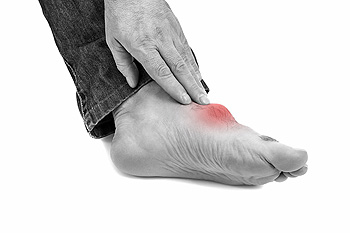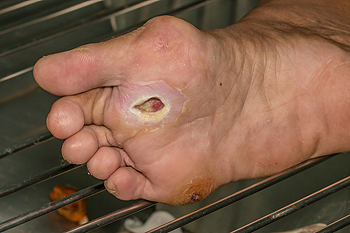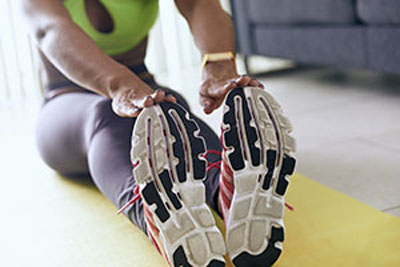Lansing (517) 321-1199

 There are several types of arthritis, including gout. It is known to be a painful condition that generally affects the big toe. Some of the symptoms that are associated with gout can include severe pain and discomfort, redness, and the affected area may feel hot. It may occur as a result of elevated uric acid levels in the blood, and can form crystals which lodge in the joints of the big toe. Existing factors that may increase the chances of being afflicted with gout can consist of being diabetic, having high blood pressure, or being overweight. There are methods that can be taken which may prevent gout attacks. It is helpful to reduce alcohol intake, eliminate food and drinks that have high sugar levels, and avoid red meat. If you have experienced a gout attack, it is strongly recommended that you are under the care of a podiatrist.
There are several types of arthritis, including gout. It is known to be a painful condition that generally affects the big toe. Some of the symptoms that are associated with gout can include severe pain and discomfort, redness, and the affected area may feel hot. It may occur as a result of elevated uric acid levels in the blood, and can form crystals which lodge in the joints of the big toe. Existing factors that may increase the chances of being afflicted with gout can consist of being diabetic, having high blood pressure, or being overweight. There are methods that can be taken which may prevent gout attacks. It is helpful to reduce alcohol intake, eliminate food and drinks that have high sugar levels, and avoid red meat. If you have experienced a gout attack, it is strongly recommended that you are under the care of a podiatrist.
Gout is a painful condition that can be treated. If you are seeking treatment, contact Dr. Harold Sterling from Michigan. Our doctor will treat your foot and ankle needs.
What Is Gout?
Gout is a form of arthritis that is characterized by sudden, severe attacks of pain, redness, and tenderness in the joints. The condition usually affects the joint at the base of the big toe. A gout attack can occur at any random time, such as the middle of the night while you are asleep.
Symptoms
Risk Factors
Prior to visiting your podiatrist to receive treatment for gout, there are a few things you should do beforehand. If you have gout you should write down your symptoms--including when they started and how often you experience them, important medical information you may have, and any questions you may have. Writing down these three things will help your podiatrist in assessing your specific situation so that he or she may provide the best route of treatment for you.
If you have any questions, please feel free to contact our office located in Lansing, MI. We offer the newest diagnostic and treatment technologies for all your foot care needs.
Read more about Gout Nail fungus, typically picked up from not wearing the proper footwear in communal showers, locker rooms, and swimming pools, is contagious and can lead to a great deal of pain if left untreated. When the fungus gets under the nail, it will likely cause the toenail to thicken, harden, and become discolored. The nail may also become brittle and fall off. Those with diabetes, circulatory issues, or an immune deficiency are more likely to develop a toenail fungus infection. Your chances of getting an infection may also increase with age. As far as treating the infection, we recommend you see a podiatrist as soon as possible for a physical exam, as well as to get a sample of your nail tested to determine if the infection truly is fungal. Once diagnosed, a podiatrist may suggest oral treatments, topical treatments, laser treatments, or for more severe cases, surgical treatments. For professional care and an advised treatment plan, we recommend you consult with a podiatrist as soon as possible.
Nail fungus, typically picked up from not wearing the proper footwear in communal showers, locker rooms, and swimming pools, is contagious and can lead to a great deal of pain if left untreated. When the fungus gets under the nail, it will likely cause the toenail to thicken, harden, and become discolored. The nail may also become brittle and fall off. Those with diabetes, circulatory issues, or an immune deficiency are more likely to develop a toenail fungus infection. Your chances of getting an infection may also increase with age. As far as treating the infection, we recommend you see a podiatrist as soon as possible for a physical exam, as well as to get a sample of your nail tested to determine if the infection truly is fungal. Once diagnosed, a podiatrist may suggest oral treatments, topical treatments, laser treatments, or for more severe cases, surgical treatments. For professional care and an advised treatment plan, we recommend you consult with a podiatrist as soon as possible.
If left untreated, toenail fungus may spread to other toenails, skin, or even fingernails. If you suspect you have toenail fungus it is important to seek treatment right away. For more information about treatment, contact Dr. Harold Sterling of Michigan. Our doctor can provide the care you need to keep you pain-free and on your feet.
Symptoms
Treatment
If self-care strategies and over-the-counter medications does not help your fungus, your podiatrist may give you a prescription drug instead. Even if you find relief from your toenail fungus symptoms, you may experience a repeat infection in the future.
Prevention
In order to prevent getting toenail fungus in the future, you should always make sure to wash your feet with soap and water. After washing, it is important to dry your feet thoroughly especially in between the toes. When trimming your toenails, be sure to trim straight across instead of in a rounded shape. It is crucial not to cover up discolored nails with nail polish because that will prevent your nail from being able to “breathe”.
In some cases, surgical procedure may be needed to remove the toenail fungus. Consult with your podiatrist about the best treatment options for your case of toenail fungus.
If you have any questions, please feel free to contact our office located in Lansing, MI. We offer the newest diagnostic and treatment technologies for all your foot care needs.
Read more about How to Treat Your Toenail Fungus
 Elevated blood sugar levels may cause foot conditions in diabetic patients. A loss of feeling may develop in the feet, which is referred to as neuropathy, and this can make it difficult to feel any sores or cuts that may be on the feet. An open sore may become infected, and develop into a foot ulcer. If this is left untreated, it may lead to amputation. There are several symptoms that can indicate serious foot conditions in diabetic patients. These can include a tingling sensation, staining on the socks, and the feet may feel cold. It is strongly advised that patients who are afflicted with diabetes are under the routine care of a podiatrist who can help them to efficiently manage this condition.
Elevated blood sugar levels may cause foot conditions in diabetic patients. A loss of feeling may develop in the feet, which is referred to as neuropathy, and this can make it difficult to feel any sores or cuts that may be on the feet. An open sore may become infected, and develop into a foot ulcer. If this is left untreated, it may lead to amputation. There are several symptoms that can indicate serious foot conditions in diabetic patients. These can include a tingling sensation, staining on the socks, and the feet may feel cold. It is strongly advised that patients who are afflicted with diabetes are under the routine care of a podiatrist who can help them to efficiently manage this condition.
Diabetic foot care is important in preventing foot ailments such as ulcers. If you are suffering from diabetes or have any other concerns about your feet, contact Dr. Harold Sterling from Michigan. Our doctor can provide the care you need to keep you pain-free and on your feet.
Diabetic Foot Care
Diabetes affects millions of people every year. The condition can damage blood vessels in many parts of the body, especially the feet. Because of this, taking care of your feet is essential if you have diabetes, and having a podiatrist help monitor your foot health is highly recommended.
The Importance of Caring for Your Feet
Patients with diabetes should have their doctor monitor their blood levels, as blood sugar levels play such a huge role in diabetic care. Monitoring these levels on a regular basis is highly advised.
It is always best to inform your healthcare professional of any concerns you may have regarding your feet, especially for diabetic patients. Early treatment and routine foot examinations are keys to maintaining proper health, especially because severe complications can arise if proper treatment is not applied.
If you have any questions please feel free to contact our office located in Lansing, MI. We offer the newest diagnostic and treatment technologies for all your foot and ankle needs.
Read more about Diabetic Foot Care When the feet are frequently stretched, painful foot and ankle injuries may be avoided. The tendons, ligaments and muscles of the feet may become stronger when a stretching regime is routinely performed. An effective stretch for the toes can consist of placing your feet flat on the floor while sitting down. As the heels are kept on the floor, raise the toes up and down until the ball of the foot lifts off the floor. This can be beneficial in building flexibility and mobility. Some patients find it helpful to walk barefoot on the sand, as this can help to add strength to the overall feet and calves. If you would like more information about how stretching can help the feet, it is suggested that you speak to a podiatrist.
When the feet are frequently stretched, painful foot and ankle injuries may be avoided. The tendons, ligaments and muscles of the feet may become stronger when a stretching regime is routinely performed. An effective stretch for the toes can consist of placing your feet flat on the floor while sitting down. As the heels are kept on the floor, raise the toes up and down until the ball of the foot lifts off the floor. This can be beneficial in building flexibility and mobility. Some patients find it helpful to walk barefoot on the sand, as this can help to add strength to the overall feet and calves. If you would like more information about how stretching can help the feet, it is suggested that you speak to a podiatrist.
Stretching the feet is a great way to prevent injuries. If you have any concerns with your feet consult with Dr. Harold Sterling from Michigan. Our doctor will assess your condition and provide you with quality foot and ankle treatment.
Stretching the Feet
Being the backbone of the body, the feet carry your entire weight and can easily become overexerted, causing cramps and pain. As with any body part, stretching your feet can serve many benefits. From increasing flexibility to even providing some pain relief, be sure to give your feet a stretch from time to time. This is especially important for athletes or anyone performing aerobic exercises, but anyone experiencing foot pain or is on their feet constantly should also engage in this practice.
Great ways to stretch your feet:
Individuals who tend to their feet by regular stretching every day should be able to minimize foot pain and prevent new problems from arising.
If you have any questions, please feel free to contact our office located in Lansing, MI. We offer the newest diagnostic and treatment technologies for all your foot care needs.
Read more about How to Stretch Your Feet